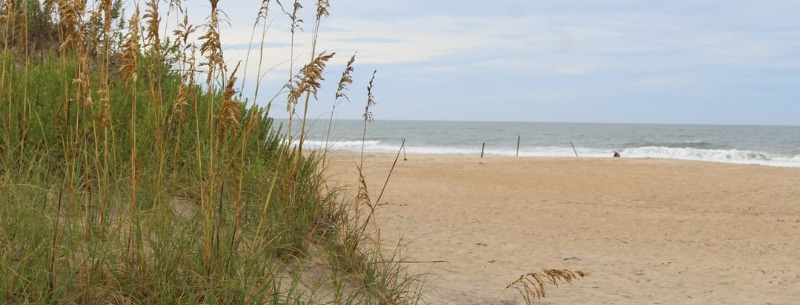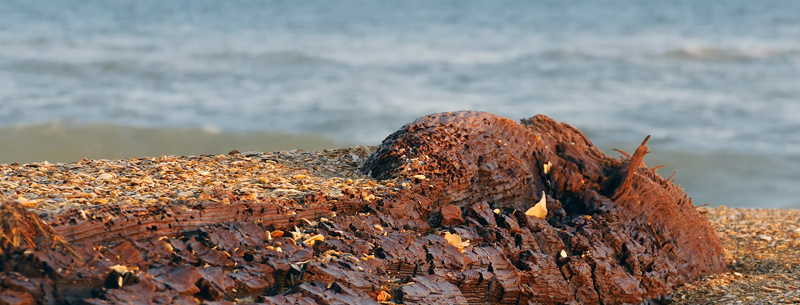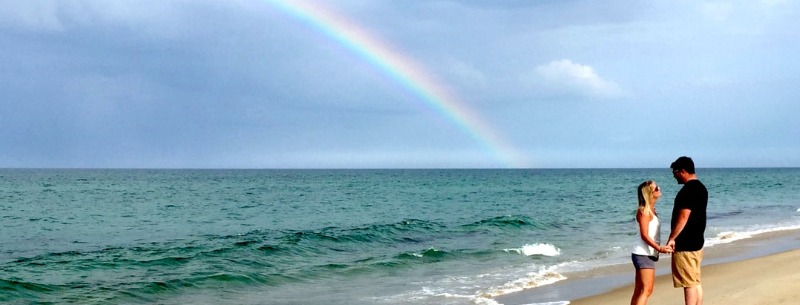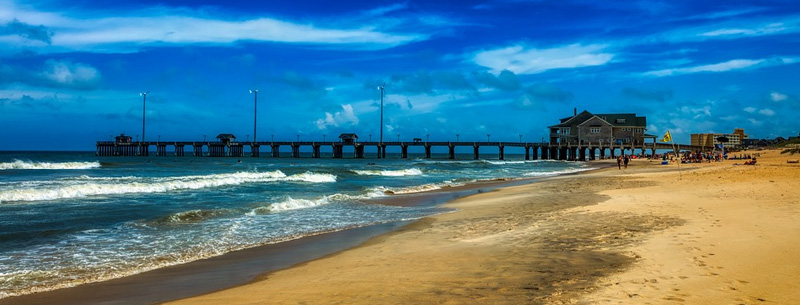Best Beaches in North Carolina
North Carolina, though the most industrialized of the Southern states, remains relatively rural and poor, with just six million people spread over an area larger than England.
It’s no surprise that North Carolina has some of the best beaches in the country. Many people wonder what the best North Carolina beaches are, and the truth is that it’s difficult to narrow them down. There are numerous beaches in North Carolina that are well worth a visit.
Geographically, North Carolina breaks down into three distinct areas – running from east to west, the coast, the Piedmont and the mountains – that help make it one of the more interesting states to tour around.
For visitors, the coast is the most promising area, with good beaches, beautiful landscapes and a fascinating history.
Bald Head Island
Don’t miss the beachfront of Bald Head Island, which is one of North Carolina’s most beautiful beach views. Visit Bald Head Island to take your beach vacation to the next level. You will have the best island experience in this laid-back and relaxing beach setting, which has a grand ocean view and lavish accommodations.
The fact that no cars are permitted on the island’s shores truly distinguishes it. Once on the island, the only traffic you’ll encounter is golf carts hopping from the beach to the golf courses to one of the island’s fantastic dining options. This island has 12,000 acres, and developers have left the vast majority of it untouched, providing visitors with access to pristine natural settings.
Beaufort
Beaufort, about 150 miles southeast of Raleigh, is probably the nicest of North Carolina’s coastal towns: a relaxing place to hang out and drink cold beer, or just sit around on the waterfront, which heats up at night.
South of Beaufort, the beaches along the twenty-mile offshore Bogue Bank are always pretty crowded, especially Atlantic Beach at the east end, with Emerald Isle, to the west, marginally less so.
On Bear Island to the south, though – reached by ferry (April-Oct, hours vary; $2) with a strict limit on the number of daily passengers – the stunning Hammocks Beach State Park has high sand dunes, a wooded shore and perfect beaches.
The entrance is four miles west of Swansboro; register at the small park center if you want to camp. No camping is permitted in turtle season (March and April), however, when loggerhead sea turtles come ashore to lay their eggs.
On the far side of the Camp Lejeune US Marine base, Topsail Island, yet another sand bar of resorts, is considerably less built up than Bogue Bank, presumably because its beaches aren’t quite as good.
Surf City and Topsail were once both slightly run-down family resorts, but seem to have improved nicely, possibly due in part to a beating from a couple of hurricanes. Public beach access points are signposted from the main road, but you can get down from lots of other places.
Cape Hatteras National Seashore
Cape Hatteras National Seashore stretches south onto Hatteras and Ocracoke islands, with wonderful unspoiled beaches on its seawardside.
Most tourists just drive straight through on Hwy-12, and even in high season you can pull off the road and walk across the dunes to deserted beaches.

The salt marshes on the western side are also beautiful, and at the northern end of Hatteras Island the Pea Island National Wildlife Refuge has trails and observation platforms from which you can see a wide variety of birdlife.
More than six hundred ships have been wrecked along this treacherous stretch of coast since the sixteenth century. At the south end of Hatteras Island, not far from the early nineteenth-century black-and-white-striped Cape Hatteras Lighthouse, a visitor center has exhibits on the island’s maritime history.
Various motels, food shops and adequate restaurants are scattered through the fly-blown settlements along Hwy-12.
Camping is best at one of the summer-only, first-come, first-served National Park Service campgrounds near Salvo, Buxton and Frisco. Ocracoke and Bodie Island ranger stations at the entrances to the seashore keep daily lists of what’s available.
Cape Lookout National Seashore
The mainland between Cedar Island and Beaufort is a rural backwater, sparsely settled and hardly touched by tourists.
It’s reasonably attractive to wander around, but towns such as Davis and Smyrna don’t have any accommodation, and the most likely reason to pass through is to get to the all-but-deserted Cape Lookout National Seashore, a narrow ribbon of sand stretching south of Ocracoke Island along three undeveloped Outer Banks, with no roads or habitation.

Its few visitors share a total of around 56 miles of beach along all three islands, with the marshes on the landward side supporting rich and unusual plant and birdlife adapted to the harsh, salty conditions.
At the northern tip of the North Core Banks, across from Ocracoke, stand the pretty, but eerie, ruins of the abandoned village of Portsmouth Village, whose last two residents left in 1971.
The main ferry for the island, from Atlantic, lands seventeen miles south of Portsmouth Village, which you can only reach on foot. Groups of travelers are taken by ferries to or from Ocracoke.
The South Core Banks is served in summer by one private ferry each way per day from Davis. Three passenger ferries run to the southern tip of the south island from low-key Harker’s Island, to within two or three miles of Cape Lookout itself and its lighthouse.
Ferries also go to the peaceful Shackleford Banks, inhabited by feral horses since the early 1500s. Check with park headquarters for schedule (tel 252/728-2250).
Carolina Beach
With a marina providing access to some of North Carolina’s best fishing spots, a secluded camping area beneath towering trees, and miles of hiking trails that traverse a variety of distinct habitats—not to mention the presence of the Venus flytrap, one of the world’s most unique carnivorous plants – it’s no wonder Carolina Beach State Park is a popular coastal attraction.
Located in an area steeped in both history and natural diversity, the park includes a visitor’s center with exhibits depicting the wonders of its environment.
Carolina Beach State Park offers access to a variety of waters. The fresh waters of the Cape Fear River, the estuarine waters of Masonboro Sound and the salt waters of the Atlantic Ocean are all only moments away.
A marina with two launching ramps and more than 40 boat slips is located at the junction of Snow’s Cut and the Cape Fear River. Fuel, snacks and restrooms are available in the marina building.
Fish from the river bank,the wheelchair-accessible fishing deck or launch your boat at the marina. Spot, flounder, sheepshead and striped bass are waiting at Carolina Beach State Park.
More than six miles of trails wind through a variety of distinct habitats at Carolina Beach State Park. Relatively flat and easy to walk, the trails offer an opportunity to observe the diversity of plant and animal life in the park.
The Carolina Beach State Park picnic area is located near the bank of Snow’s Cut, between the campground and marina. Under the shade of large oak trees, tables and grills supply all the necessities for dining.
Emerald Isle
Consider visiting the absolutely perfect beaches and comfortable atmosphere of the elegant Emerald Isle if you’re looking for the best beach to swim in North Carolina. Emerald Isle is well-known as a family beach vacation destination. Emerald Isle is simply a beach setting you cannot resist because it offers a plethora of amenities and outdoor activities. During the summer, the beach also has scenic warm ocean waters for swimmers to enjoy, making this an exceptional beach worth visiting.
Take long walks through the maritime forest that dims the island in green and visit The Point for one of the finest sunsets on the east coast. Its central location on the coast also makes it an excellent starting point for further exploration.
Nags Head
If you’re looking for popular beaches in North Carolina, don’t miss out on the calming sandy shores of Nags Head. Nags Head’s scenic beaches are ideal for making precious memories with your loved ones, as they feature pristine coastlines, occasional dolphins, and warm sunshine. Furthermore, the beach is a well-known family holiday hotspot, is open to the public, and is handicap-friendly—a beach destination worthy of note. If you plan to stay and watch the sunset with your family, try to obtain a permit that allows you to build beach fires on the beach.

Jockey’s Ridge State Park, right next door, has dunes that are larger than life. Visitors can spend a day exploring the area, which feels like a desert next to the sea.
Ocracoke Island
Ocracoke Island (pronounced oke-ruhcoke ) is forty minutes by ferry from Hatteras – and is even more beautiful.
This 14-mile ribbon of land is bisected by Hwy-12, and it’s perfectly possible to drive along and pull over to find yourself a deserted patch of beach.
Despite the crowds of tourists in the village of Ocracoke itself, at its southern tip, the island somehow seems to have hung on to its atmosphere.
There’s nothing in particular to see on the island, except perhaps the harbor and squat brown lighthouse (you can’t go in), and a tiny British World War II naval cemetery.
It’s nicer instead just to catch some rays, take a stroll or enjoy a cycle ride; bike rental places include Island Rentals on Silver Lake Road.
Hotels and B&Bs; in Ocracoke village get full in summer, and are fairly expensive; as elsewhere on the Outer Banks, rates drop in September.
The Anchorage Inn, on Route 12, is comfortable, with a pool and complimentary continental breakfast and also offers apartments with kitchenettes; or you could sleep in one of the unusual “crow’s-nest” rooms in the 1901 Island Inn and Dining Room, on Hwy-12, whose restaurant is renowned for its crabcakes.
Other, less expensive restaurants include the Back Porch, on Back Road, which serves great fish, and the lively Howard’s Pub & Raw Bar, a mile north of the village on Hwy-12), which has over two hundred beers and serves a full menu until 2am.
The fairly isolated Park Service campground, a few miles north, tends to be the first of the Outer Banks sites to fill up. Tentsites start from $12.
Outer Banks
The Outer Banks are a series of long sand bars, sprinkled with wispy sea oats, that stretch about 180 miles from the Virginia border to Cape Lookout, near Beaufort.
They are a great place to wander at your own speed, although unfortunately there’s no public transportation apart from the ferries between islands and to the mainland.

The main road from the north, US-158, crosses from the mainland on a low bridge, where you’re greeted by a roadside visitor center.
South along US-158 and the parallel shoreline Beach Road, the coastal towns of Kitty Hawk, Kill Devil Hills and Nags Head are strung out without a break, and the fine warm-water beaches are lined with motels and fast-food places mixed in with huge vacation “cottages.”
Note that when Outer Banks hotels describe themselves as “waterfront,” it simply means they are on the coastal side of the road, not that they necessarily have ocean views.
Topsail Island
This hidden gem is worth noting among all of the North Carolina beaches on this list. This beach, which has historical ties to World War II, also has a family-friendly beach experience that will speak to your heart. With nearby motels, restaurants, gift shops, and other amenities, it would be silly not to consider visiting this stopping point. This destination’s Serenity Point offers a panoramic sunset view that will keep you coming back for more.
Every fall, the beach hosts an art crawl to mark the end of the high season. Local artists travel from all over the state to showcase the best of what beach life has to offer. A public marina and fishing pier add to the entertainment options.
Wilmington
Though it’s the largest town on North Carolina’s coast, Wilmington, set back along the Cape Fear River fifty miles short of the southern border, has a welcoming down-home feel.
Wilmington today is attractive and friendly, with a historic district, starting on the south side of Market Street and stretching east along Third Street, that feels genuinely lived in.
At 814 Market St, the Cape Fear Museum gives a lively account of local history, while Louise Wells Cameron Art Museum, features works by the nineteenth-century Impressionist Mary Cassatt.
The extravagant houses ornate City Hall and lovely old Thalian Hall demonstrate Wilmington’s former wealth, but it’s the cobbled streets of the weathered, boardwalked waterfront, dotted with laid-back cafes and restaurants, that really appeal.
The blocks back from the waterfront are lined with quirky thrift shops and memorabilia troves.
Wilmington’s notoriety as a popular film location has earned it the nickname “Hollywood East.” Blue Velvet and Teenage Mutant Ninja Turtles were shot in the area.
Twenty miles south on Hwy-421, near Kure Beach, Fort Fisher State Historic Site commands a spectacular rocky position overlooking both the sea and the mouth of the Cape Fear River.
